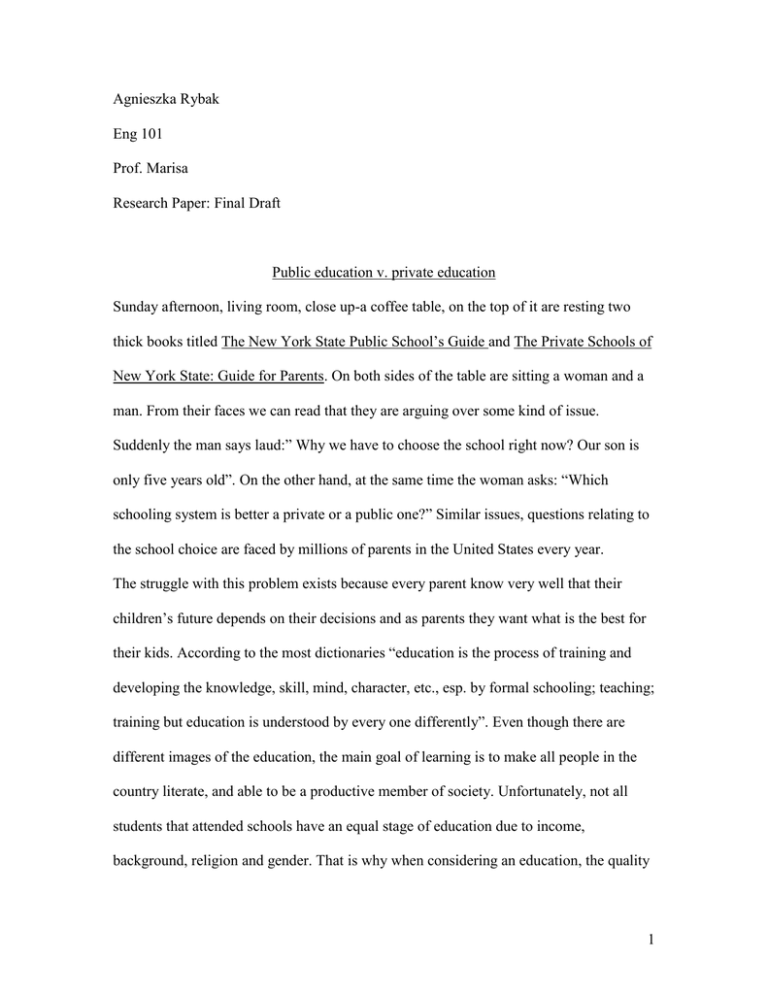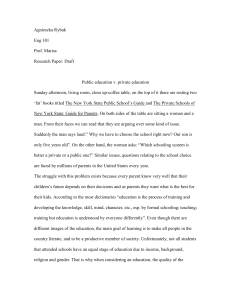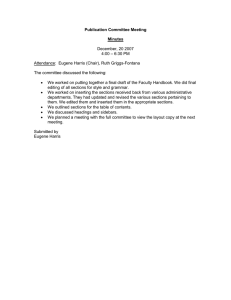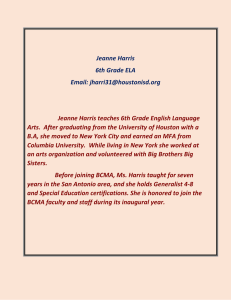Agnieszka Rybak Eng 101 Prof. Marisa Research Paper: Final Draft
advertisement

Agnieszka Rybak Eng 101 Prof. Marisa Research Paper: Final Draft Public education v. private education Sunday afternoon, living room, close up-a coffee table, on the top of it are resting two thick books titled The New York State Public School’s Guide and The Private Schools of New York State: Guide for Parents. On both sides of the table are sitting a woman and a man. From their faces we can read that they are arguing over some kind of issue. Suddenly the man says laud:” Why we have to choose the school right now? Our son is only five years old”. On the other hand, at the same time the woman asks: “Which schooling system is better a private or a public one?” Similar issues, questions relating to the school choice are faced by millions of parents in the United States every year. The struggle with this problem exists because every parent know very well that their children’s future depends on their decisions and as parents they want what is the best for their kids. According to the most dictionaries “education is the process of training and developing the knowledge, skill, mind, character, etc., esp. by formal schooling; teaching; training but education is understood by every one differently”. Even though there are different images of the education, the main goal of learning is to make all people in the country literate, and able to be a productive member of society. Unfortunately, not all students that attended schools have an equal stage of education due to income, background, religion and gender. That is why when considering an education, the quality 1 of the education is almost as important as the education itself. So when picking the school for children comes onto the stage, the debate between public and private schooling system began. With the increasing demand for better schools, states and communities are providing more options to families. Those optional school choices are: publicly funded school choice program, charter schools, magnet school and private scholarship programs. By allowing parents to choose the school, they are not only improving educational opportunities for children, but also having a dramatic impact on how schools operate. “In the 1700s a primary goal of education was for children to be able to read the Bible” (Harris 145). As history indicates early system of schooling didn’t expect from young citizens much, only the ability to read religious books like Bible or Koran depends of child family’s tradition. Today on the other hand, every kid after graduation is estimated to not only read but also write, solve math problems, think critically and communicate well. That’s why right now parents who want their children process all those characteristics of well educated person, choose schools that the best fit their needs. Typically, way before considering private or public school, parents first will have to determine what a “good school” is and which factor will the best satisfy their expectation. “An analysis of research on characteristics of school that reflect high quality, goodness, and success… [says] that” (Harris 137) academic reputation, school size and class size, safety reputation, costs, religious and moral instruction; quality of teachers are the most major factors, which come into play, when looking at private or public schools. “An unswerving attitude of care, respect …toward students and parents” (Harris 137) is one of the first important qualities of a good school. Without a respectful manner toward students and her/his parents, school with the best curriculum won’t be considered 2 as a good choice for a young mind because school’s target is not only teach you how to solve math equation but also how to interact with other people in different situations. The “evidence of provision for safe and regulated environment” (Harris 137) is the second very significant attribute of good school. In today’s world where drugs like narcotics and weapons are easily accessible the safeness and discipline is a prior element of good school. Surely none parent wish for his/her children a similar situation to happen like the one that took place in one of West Virginia’s college where a student entered the campus with gun and killed several people with the cold blood. Another and also an important element of a good school is “disciplinary code… [and] a solid foundation of authority”(Harris 137). Students who attend schools that beside good teaching system also emphasizes discipline and the authority, helps parents to teach their children a values of being a productive citizen. “Clearly stated academic goals and a clearly defined core curriculum” (Harris 138) is an element that helps students and their parents in very young stage discover student’s ability that then can be used to succeed in adult life. But to help kids become a good member of the society “high quality teachers who are academically qualified” (Harris 138) is a must. The schools that have a scholars that are well educated and know how to pass their knowledge to their students, is the institution that doesn’t waist children time and sometimes money. Now that we recognized some of the main factors of “good school” that parents take under consideration when deciding whether to enroll their children in private or public school, let’s look at the factors closer. Private and public schools are those institutions that are mostly considered by parents when choosing the school for children 3 and those two kinds of school system are mostly mentioned in debate because they differ in many organizational aspects. One of the first aspects that vary greatly private school from public is academic reputation. Educational standing is the feature that plays a big role when considering private versus public school. Those both school’s systems contrast significantly in their academic curriculum. “Private schools [for example] are more likely to define clear boundaries and stick to a course that the school head and /or the majority on the school’s governing body deems best for the school” (Glenn 4). Unlike public schools, private “schools focus on academics…,all students are expected to take a solid schedule of relatively challenging academic courses to the exclusion of many of the ‘soft’ courseofferings found in the general track in public high schools” (Kahlenberg 35). This usually includes math, English, reading, writing, science, history, and physical education. That means that private schools usually have flexibility to create specialized programs for students. For instance, private institutions may use art or science in all classes, or take children on outdoor trips. On the other hand, “public schools do not have this option. They must live with dissent, often making changes first in one direction and then another” (Glenn 4).They” have been controlled in their teaching… by laws and court decisions”(Harris 107). In general speaking, what students learn in public school is strictly controlled by the state, which at the end of trimester measured it through standardized tests. Plus the satisfied minimum achievement criteria in each course offered in public school are put forward by the state and each student must achieve this minimum norm in order to receive credit. 4 The best evidence that private schools actually have better educational reputation than public ones is study, which showed that “African Americans and Hispanic have gained the most from [private] schooling. They have substantially higher levels of educational attainment and academic achievement when they attended [private] schools” (Glenn 4). Through this study we can learn that some people who finished private school would never achieve the same higher level of academics if they have gone to public schools. Still, we need to remember that the school’s ability to execute on students academic goals is closely correlated with school size and class size. That’s why another element that parent should pay attention while choosing the right is class and school size. For example, they need to make sure to check how many children will the classroom teacher be responsible for? The size of class and school is important element basically because when a school gets too big, it can become troublesome to administer and in result students and programs instead of educational success they may sustain a defeat. “According to the Council of American Private Education (CAPE), of the 53million school children in America today, [only] 5, 927, 00 students are enrolled in private schools which represent 11%….while nearly 90%” (Hariss 73-74) of children of the United Sates are students of public schools. From above mentioned facts we clearly see that public schools are overloaded and classes are at lease twice the size of private schools which isn’t favorable in terms of gaining good educational proficiency by a student. At the same time “the typical class size … [at private school] is 15, and the student-teacher ration is 14:1” (Harris 101), this information shows us that students of private school have biggest chance to get individual attention form teacher in case she/he needs a assistance with schoolwork. As we can observe private schooling because of 5 small classes give students more possibility to succeed in they studies than those who attend crowed public schools. Furthermore, safety and the general school environment are other aspects that parents should consider while choosing the school. In today’s world where alcohol, drugs and even weapons are easily accessible for any one safe school’s settings are very significant likewise for students and their parents. Even though, nowadays most of public schools have secure surroundings, still in some school districts, students might be safer in private schools. “Drawing from earlier work …, ‘deviant behavior,’ such as drinking, fighting, and sexual activities… [where less likely demonstrated by students of] private schools than….public schools” (Suitor 11). It is said that “private schools…reflect…more [on] ‘traditional values’ [which according to] parents …will be exposed… [on] academic setting—specifically, greater emphasis on academic achievement and sociability …and less emphasis on ‘frivolous’ characteristics, such as appearance [that lacks in public schooling system]” (Suitor 11). One of the strict requirements of private schools are uniforms, parents who decide to send their children to private institution must remember about it because in the case they sent they children without them they won’t be permitted to enter the school and attend classes. Private institutions believe that having children dressed the same could prevent an outsider enter the school building and/or cause any threat to students. For instance, every time I had to go and see my brother’s teach or/and the school administrator first they sent a letter to my house, which I had to sign and return. Later on my would bring me another letter that stated when and what time I had to arrive there because the school’s door were closed and any one who wanted to enter the school had to ring the bell and then show the permeation letter to be allowed to step 6 inside. On the contrast, public school that my brother attended didn’t have this type of procedure; there I could enter the school anytime during the day. Even once I was mistakenly taken by a guard for the student and almost sent to the principle office for coming late. From those two examples we can clearly see that safety in some schools is a priority and in others not. Cost is another important factor that impacts the private school versus public school decision. Simply put, private schools charge tuition whereas public schools are offered free of charge. For many parents, this is the hardest factor with which to come to terms. While “more than 90 percent of public funding for elementary and secondary [public] education comes from state and local governments”(Godwin 171), private schools depend mainly on tuition fees and funds coming from parents and non-public sources such as religious organizations and/or charitable donations. Public schools “use their school’s Title I fund to pay for tutoring, or, in edspeak, ‘supplemental services.”(Hess 63) State Constitutions prohibits public schools from charging residents any form of tuition or other fees for materials, supplies, textbooks or transportation. On the other hand, private schools do not receive tax revenues but are funded through tuition, donations and private grants. Therefore, patents who decide put their children to private schools are expected to pay tuition cost which isn’t low. “The average tuition for an elementary school student [is at least ]$ 1,787 per year, and the median tuition for a high school freshmen student [is around] $ 4,300” (Harris 90). The next factor that also plays a large role whether to send children to public or private school is whether or not parents want religious and/or moral instruction to play a part of their children’s academic setting. Not all but many private schools are religiously 7 affiliated. “The United States has approximately 114,800 schools…where [only] 8,146 [are] Catholic schools [and] 6,920 [of them are] elementary and middle schools, and 1,226[are] secondary (Harris 75, 89). As we can see from above given data most schools in America are not religiously associated which is very scary because from history, movies we can learn that American committee is religious. The best example of this will be money which on the back has clearly written statement “IN GOD WE TRUST” that gives us the affirmation of ours believes. So not teaching a religion at all doesn’t actually comply with principles of this country Finally, for many families, a final factor that impacts their decision on whether to send their children to private or public school is quality of teachers. In three areas of school policy curriculum, setting student performance standards, and setting discipline policy the quality of teachers is the sector that differ substantially. Private “schools [have] substantially higher job satisfaction, a greater sense of collegiality and community, and higher personal efficacy than public school teachers. [Private] school teachers also reported a much broader range of professional responsibilities in their school, and they exercised more control over both school-level policy and classroom practices.”(Godwin 48). Simply saying this is happening because most teachers in public schools are state certified, which means that they have gone through the training required by the state including student teaching and coursework. Public schools cannot terminate the terms of their teachers abruptly. After completing a probationary period, teachers are granted term by law. They cannot be dismissed without first going through a twelve-month rehabilitation period. This too, can only be done after a public hearing in which charges of incompetence or misconduct must be proven. 8 In contrast, private school teachers “additionally, … [are] required specialized accreditation …in areas of religious instruction, theology, and marriage, and family studies in order to promote their distinctive educational missions” (Harris 91). In general private schools have their own personnel requirements. Private institutions can terminate the terms of their teachers suddenly, if they see something is wrong with the educator, private school don’t through so many procedures like public teaching system. In conclusion, we will find that there is no overall right or wrong answer regarding whether private or public school education is best for our children today. The best thing to do when making this decision is to consider the factors and weigh which ones are important to us-parents. For some the option of having a religious involvement in kids’ education might be the only important. On contrast, for others this aspect may not play a so large role at all. However, we need to just remember that choosing a school is not a fast process, which can be done during one Sunday afternoon. Finding out first what is important is essential to us-parents will take little bit more time that’s why we will be force to get to know the real number and information regarding schools which we consider for our children. And the best advice for completing this task will be going to the schools pretty early. Therefore, most of private and public school begin their enrollment processes the year before the school year. 9 Annotated Bibliography Harris, Sandra, and Sandra Lynn Tillman Lowery, ed. A School for Every Child: School Choice in America. Maryland: Scarecrow Press, Inc., 2002. Hess Frederick M., and Chester E. Finn, Jr., ed. Leaving No Child Behind?: Options for Kids in Failing Schools . New York: Palgrave Macmillan, 2004. Glenn, Charles L. “The Debate Over Parent Choice of Schools.” Journal of Education: 2003, Vol. 184 Issue 1, p89-100, 12p, 1chart. Ebsco Host. LaGuardia Community Coll. Lib., Long Island City, NY. October 6 2007 <www.web.ebscohost.com> Godwin, R. Kenneth, and Frank R. Kemerer. School Choice Tradeoffs: Libery, Equity, and Diversity. 1st ed. Austin: University of Texas Press, 2002. Kahlenberg, Richard D., ed. Public School Choice vs. Private School Vouchers. New York: A Century Foundation Book, 2003. Suitor, J. Jill. “Avenues To Prestige Among adolescents In Public and Religiously Affiliated High Schools.” Adolescence: 2004, Vol. 39, Issue 154, p229-241, 13 p, 1 chart. Ebsco Host. LaGuardia CommunityColl. Lib., Long Island City, NY. October 6 2007 <www.web.ebscohost.com> 10



